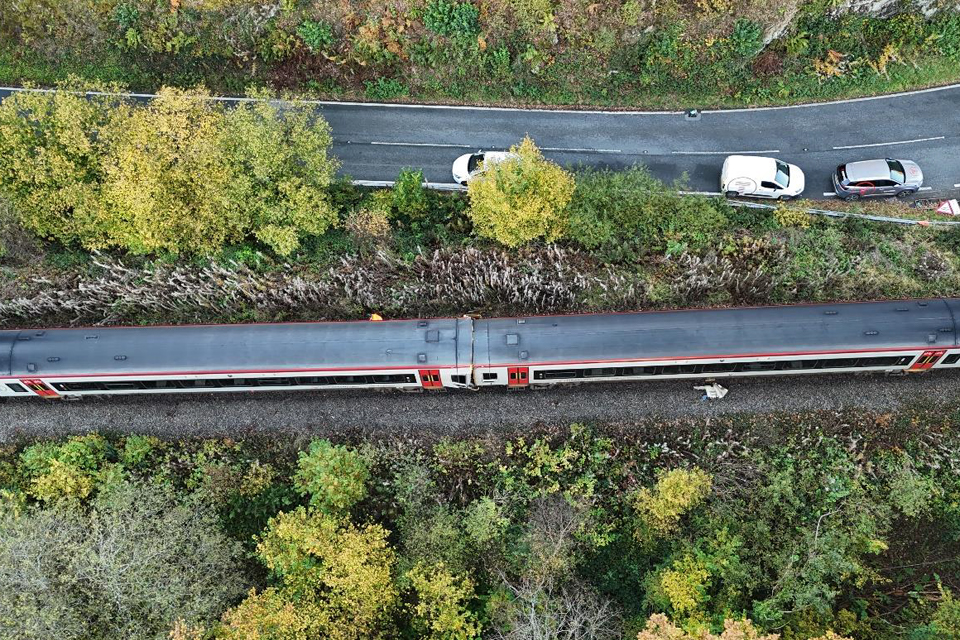Investigation Reveals Train Safety System Failure Before Fatal Crash in Wales. The collision in Powys led to one death and several injuries.

On Monday, 21 October 2024, a tragic collision between two passenger trains occurred on the Cambrian line in Powys, Wales, resulting in the death of one passenger and serious injuries to several others. At approximately 19:26, train 1J25, the 18:31 Transport for Wales service from Shrewsbury to Aberystwyth, collided with train 1S71, the 19:09 Machynlleth to Shrewsbury service, also operated by Transport for Wales. The accident took place approximately 900 metres west of the Talerddig passing loop, a critical section of single track where trains can pass each other.
The collision resulted in one fatality, identified as David Tudor Evans, 66, who was remembered as a “lovely guy, full of life and enjoyment.” Four additional passengers sustained serious injuries, while eleven others required hospital treatment for their injuries. Despite the severity of the incident, neither train derailed; however, both trains sustained significant damage to their leading vehicles.
Response and Investigation Initiated
The Rail Accident Investigation Branch (RAIB) was notified of the incident at 19:45 and dispatched a team of inspectors to the crash site. In the days that followed, RAIB collaborated closely with the British Transport Police, the Office of Rail and Road, and the railway companies involved to gather evidence for an independent safety investigation. By Wednesday evening, 23 October, RAIB released the accident site back to Network Rail to allow for the inspection and repair of the track, as well as the recovery of the trains. Both trains were cleared from the site by Friday, 25 October.
Preliminary examinations by the RAIB revealed that both trains involved were 2-car class 158 diesel multiple units, equipped with advanced safety features including wheel slide protection systems akin to anti-lock brakes in automobiles and an automatic sanding system. This system is designed to improve friction during braking by discharging sand when wheel slide is detected. However, early investigations highlighted a critical failure in the automatic sanding system on train 1J25, with the sanding hoses found to be blocked and unable to function during the incident.
Conditions Leading to the Collision
An initial analysis of data from the on-train data recorder (OTDR) of train 1J25 indicated that the driver had applied the service brakes as the train approached the loop at Talerddig. Approximately 40 seconds after this initial braking, an emergency brake was engaged, but the OTDR data showed that wheel slide commenced during the service braking phase and persisted into the emergency braking phase. As the train approached the exit of the loop, it failed to stop at the designated block marker and re-entered the single track, continuing to travel downhill for about 900 metres before colliding with the oncoming train 1S71.
There are conflicting reports regarding the speeds of the trains at the moment of collision. Preliminary findings suggest that train 1J25 was traveling between 24 km/h (15 mph) and 39 km/h (24 mph) at the time of impact, while train 1S71 was moving at around 10 km/h (6 mph). The RAIB is continuing to assess the speed and dynamics of the collision as part of its ongoing investigation.
Focus of Ongoing Investigation
The RAIB’s investigation will delve into multiple factors contributing to the accident. Key areas of focus include the actions of the train crews, the level of wheel/rail adhesion leading up to the collision, and the effectiveness of the braking and sanding systems on train 1J25. Additionally, the investigation will explore Transport for Wales' and Network Rail’s policies regarding low wheel/rail adhesion, as well as their strategies for managing the risks associated with such conditions on the Cambrian line.
The RAIB has emphasized that its investigation is independent of any inquiries conducted by the railway industry or law enforcement agencies. Upon concluding their investigation, they will publish their findings and any safety recommendations on their official website, aiming to enhance the safety protocols in the rail industry.
Latest Taxi Updates!
Headlines, Breaking News, and Top Guides—straight to you! Stay informed and ride smarter every day!
